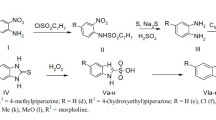Summary
The effects of combined treatment with a heparinoid-sodium pentosan polysulfate — and an antihistamine-promethazine hydrochloride — against thioacetamide-induced rat liver injury were studied.
Treatment by promethazine hydrochloride at 0 and 6 hrs by 2.5 and 1.25 mg per 100 g body weight or by 1.5 mg pentosan polysulfate did not afford a real protection against liver injury. The combined, however, of these two incompletely acting schedules treatment inhibited substantially the development of liver cellnecrosis up to 96 hrs. A synergic action of the above protective agents could be supposed.
Similar content being viewed by others
References
Bangham, A.D., Rees, K. R., Shotlander, V. L.: Penetration of lipid films by compounds preventing liver necrosis in rats. Nature (Lond.)193, 754–756 (1962)
Bartsokas, St. K., Papadimitriou, D. G., Papacharalampous, N. X., Varonos, D.: The effect of mild hypothermia in established CCl4 liver injury. Acta Hepato-Gastroenterol.20, 275–282 (1973)
Bartsokas, St. K.: Protection of liver function in thioacetamide poisoned rats by heparinoids. Res. exp. Med. (in press, 1973)
Cameron, G. R., Karunaratne, W. A. E.: Carbon tetrachloride cirrhosis in relation to liver regeneration. J. Path. Bact.42, 1–21 (1936)
Gallagher, C. H., Gupta, D. N., Judah, J. D., Rees, K. R.: Biochemical changes in liver in acute thioacetamide intoxication. J. Path. Bact.72, 193–201 (1956)
Gupta, D. N.: Acute changes in the liver after administration of thioacetamide. J. Path. Bact.72, 183–192 (1956)
Papadimitriou, D. G., Kannas, D., Bartsokas, St. K.: Histopathologische Untersuchungen an Ratten zur Beeinflussung der Tetrachlorkohlenstoff-induzierten Fettleber mit einem sulfatierten Polyanion (SP54). Med. Welt22, 100–103 (1971)
Raveux, R., Ravold, J., Segal, V., Brunaud, M.: Studies on the effect of xylane sulfate polyesters on the lipid composition of blood serum in rats receiving a high-fat diet. Progr. Biochem. Pharmacol.2, 451–458 (1967)
Rees, K. R., Sinha, K. P., Spector, W. G.: The pathogenesis of liver injury in carbon tetrachloride and thioacetamide poisoning. J. Path. Bact.81, 107–118 (1961)
Rees, K. R., Spector, W. G.: Reversible nature of liver cell damage due to carbon tetrachloride as demonstrated by the use of phenergan. Nature (Lond.)190, 821–822 (1961)
Author information
Authors and Affiliations
Additional information
This study has been supported by “G. Lyras” grant to whom the first author expresses his thanks.
Rights and permissions
About this article
Cite this article
Bartsokas, S.K., Papacharalampous, N.X., Papadimitriou, D.G. et al. Synergia of a heparinoid and promethazine hydrochloride against liver cell necrosis. Res. Exp. Med. 162, 235–241 (1974). https://doi.org/10.1007/BF01851245
Received:
Issue Date:
DOI: https://doi.org/10.1007/BF01851245



